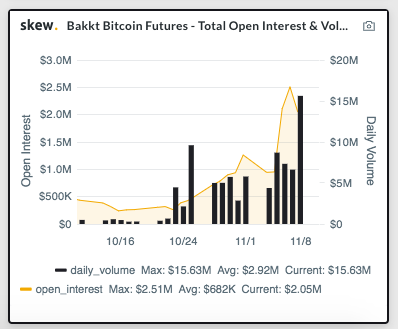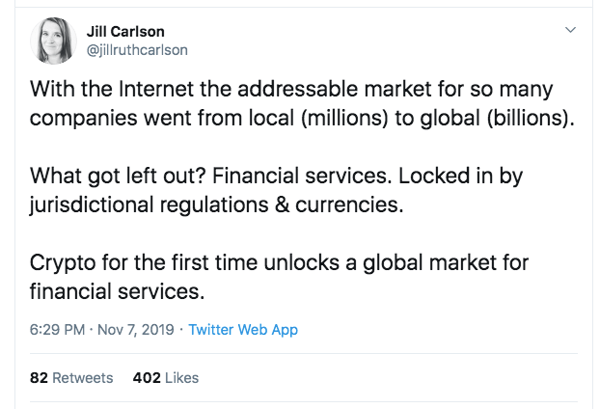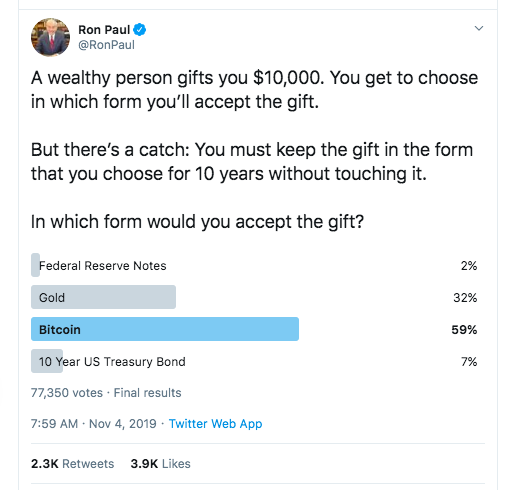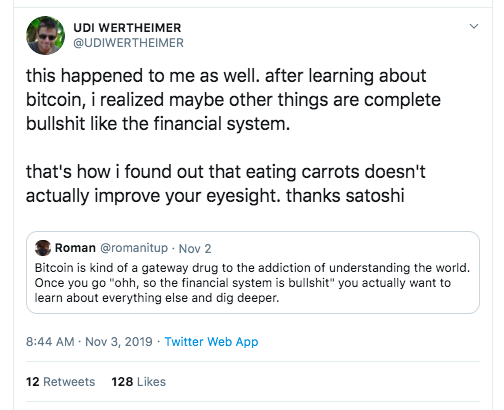What happened this week in the Crypto markets?
Bitcoin Stagnates, But Other Digital Assets Shine
It felt like 2017 again, as it’s been a while since Bitcoin traded down while many other digital assets finished the week in positive territory. While Bitcoin itself is stuck in an indecisive range, the crypto market responded positively to certain events and catalysts. Some of these events are more “sticky” than others — for example, a listing on a prominent exchange can lead to new demand and increased liquidity for a particular token, but ultimately this doesn’t create new economic value and as a result, price usually retreats shortly after a quick rise. However, other events like network upgrades, token supply reductions, and tactics that increase the utility of digital assets are usually met with more long-lasting results.
For example, Maker Dao (MKR), the token at the top of one of the fastest-growing decentralized finance loan systems, rose 30% week-over-week for 2 reasons: 1) The stable token (DAI) historically could only be loaned using Ether (ETH) as collateral, but multi-collateral DAI is launching November 18th which expands the collateral pool for obtaining loans and 2) MKR token holders voted to raise the DAI ceiling to 120M from 100M, showing increased demand for these token-backed loans. These are sustainable growth events that should add real economic value.
Bitcoin will, of course, still be what brings new market participants into crypto, but it’s encouraging to see some projects actually growing organically within the crypto ecosystem.
Speaking of Bitcoin, all eyes continue to be on China. While US equity markets cheer every headline that shows trade talks advancing between China and the US, crypto markets are more focused on actual progress. China continues to fuel growth initiatives in the crypto market. (See “What We’re Reading section), and as a result, we’re hearing anecdotally from many of our Asian counterparties that “retail investors in China are going nuts about Bitcoin right now”. This can be seen with large spikes in both volume and price recently during Asian trading hours. Coupled with Bakkt’s continued growth here in the US, and other fiat onramps (more below), there is a reason to be optimistic again.
Gateways to Crypto Adoption
We often compare the Digital Asset adoption curve to that of the mid-1990s internet. Meaning, right now, it’s slow, clunky and only tech-savvy people really care. But 20 years later, we now know how impactful the internet has been for even the least tech-savvy people.
The internet has broken down geographic barriers for dating, shopping, and information — but Financial Institutions are largely still regional.
However, this is starting to change.
Whether it's Square, J.P. Morgan, Uber, Facebook, Microsoft, NYSE-ICE, or Fidelity, there has been a flurry of announcements of forays into crypto and blockchain this year, often by publicly traded U.S. companies. Square retail users alone are now absorbing 8% of Bitcoin mining supply, while Fidelity and ICE (Bakkt) are talking to just about every institutional client on the planet. Meanwhile, Silvergate Bank just did an IPO, and crypto mining equipment maker Canaan Creative is coming to US equity markets next.
It's an exciting development to watch heading into 2020. And if you’re not paying attention to crypto simply because equities and debt are booming, you might miss the sentiment shift happening right in front of you.
Ok, Boomer
Discover the Millennials versus Boomers investment trends. My dad (73) once said to my sister and her husband (43): "You need both of your paychecks to live? Why don't you just save one of them?"
Inflation & debt — I’d like you to meet old age.
The average age of Arca employees is 39. So we may not be the best firm to discuss the “OK Boomer” meme that is sweeping the nation. But we are paying very close attention. Unlike Occupy Wall Street, which was a flawed movement against massive, well-capitalized institutions, the OK Boomer movement is pinning people (young adults) against people (baby boomers). And this is not going to end quietly.
The general sense is that the older generation, willingly or unknowingly, has stolen from future generations. This is clearly evident when it comes to debt accumulation (interesting, scary, downright terrifying), and maybe less clearly evident when it comes to things like climate change. But it is creating a cultural divide in society, no longer just “rich vs poor”, but now “young vs old”. For a deeper dive into this new divide, Collaborative Fund highlighted demographic change, wealth inequality, and access to information as the three most important shifts that will affect our world for decades - it is definitely worth reading.
Here’s a fun holiday idea: find a 20-something and a 60+ person, put them in a room, and discuss OK Boomer. Immediately, you will see a reaction. The older generation gets TICKED OFF when you suggest that they had it easy, and the younger generation will make some great points that the older generation just won’t be able to quite understand. Why? Because things that have made sense for decades without being challenged just don’t quite make as much sense to people who grew up with the internet and free-flowing information. Some examples:
- Not being able to get your money out of a bank whenever you want it (maybe that made sense when people worked 9 to 5 with a 2-hour lunch break)
- Social Security, the only well known and accepted Ponzi Scheme
- Owning a house (despite countless research that suggests this is a terrible investment)
- The ROI of going to college
- Inflation and Keynesian economics
- Medicare and Medicaid
- A 2-party Congress where nothing can really ever get done
- Religion as an explanation for “how the Earth works” like evolution and ocean tides
The list goes on and on with elements of society where we accept the status quo despite it making literally no sense anymore. The older generation has lost touch with the younger generation, and for the first time, the younger generation has a loud microphone (social media) and a solution (Bitcoin and other digital assets).
This is the information world — no longer will people accept what doesn’t make sense. Again, we’re watching very closely.
Notable Movers and Shakers
Bitcoin has temporarily stagnated in recent weeks, so the market has shifted its focus towards idiosyncratic event-centric news. Tokens with catalysts are excelling, with two standing out last week:
- Stellar (XLM) burned a little over half (55B XLM, $4.4B) of their total supply (105B) as they look to advance their project’s development plans. While this event is seen as bullish (XLM finished the week up 15%), there was significant commotion in the space that the market did not behave rationally (halving the supply in one swoop didn’t double the price, what gives?). However, this assumption ignores some key points: 50B of the 55B XLM tokens burned (92%) were allocated towards user growth and partnership programs (which are now left with 18B XLM, 26%), and that the circulating supply is only 20B XLM. The former points to the Stellar Development Foundation (SDF) operations gaining a larger piece of the XLM pie (24% from 16%), whereas the latter explains why the price did not increase linearly with the burn - these tokens had not yet hit the market, and therefore were not priced in. Nonetheless, it was an interesting step to take by the SDF, and we expect other projects to follow suit in the future as their token economics come into question.
- Tezos (XTZ) staking went live on Coinbase on Wednesday, allowing US customers to stake their XTZ directly on the platform. Staking XTZ is available (and even financially advantageous) elsewhere, but Coinbase has opened up the possibility for many users who do not want to deal with the intricacies of utilizing the Tezos network. The market reacted in force to this news, with XTZ finishing the week up 41%.
What We’re Reading this Week
Hong Kong’s financial regulator, the Securities and Futures Commission (SFC), last week released guidelines for crypto exchanges. The SFC had previously allowed exchanges, many of the largest ones are based in Hong Kong, to operate independently as the assets they traded were not deemed securities. However, after “in-depth examination of their unique technical and operational features,” the SFC has decided to set guidelines for exchanges to follow. The new rules will be similar to rules for securities brokerages, but it is not yet clear how many exchanges will apply and qualify for the SFC’s new license.
Last week, Silvergate, the crypto-friendly bank based out of San Diego, went public on the NYSE. Silvergate, which has total deposits of $1.8b, currently serves 756 digital-currency related firms. Access to banking services for firms in the digital asset space is incredibly difficult as most commercial banks refuse to serve these clients. The public equity of Silvergate is now another way that the broader financial market can become aware and even get exposure to crypto.
Some of Asia’s largest asset managers last week published a paper which describes a future where tokenized securities are “part of the mainstream institutional toolkit”. For such a future to occur, however, regulatory clarity is needed - something that the group calls for in its paper. The group which includes Nomura, Standard Chartered and Citigroup, touts the added efficiency, scalability and liquidity offered by blockchain-based assets. Although it is positive to see large asset managers begin to take notice of the benefits of tokenization, adoption and usage may be far off as regulation still needs to catch up.
In another pro-cryptocurrency move last week, China removed cryptocurrency mining from a list of restricted activities. The industry had previously been cited on a list of industries to be phased out according to China’s government-controlled economic planning agency. Half the Bitcoin hashing power comes from China, and China is the home base of the largest manufacturers of mining equipment (Bitmain, Canaan, and Ebang). The government’s new stance has offered clarity and relief to these groups and further cements China’s ambition to grow and adopt digital assets.
Jet Token, a company that is building an Ethereum-based marketplace for customers to lease private jets using ERC20 based tokens, is planning to raise $10m. The company will compete with Turnkey Jet, the first company to receive a no-action letter from the SEC earlier this year for its token sale. JetToken on the other hand, will raise the $10m through an equity offering under the Regulation A exemption. The company currently has an iOS version of its app released with plans to include crypto payments in another iteration by year end.
And That’s Our Two Satoshis!
Thanks for reading everyone!
Questions or comments, just let us know.
The Arca Portfolio Management Team
Jeff Dorman, CFA - Chief Investment Officer
Katie Talati - Head of Research
Hassan Bassiri, CFA - PM / Analyst
Sasha Fleyshman - Trader
Wes Hansen - Head of Trading & Operations
To learn more or talk to us about investing in digital assets and cryptocurrency
.jpg)



